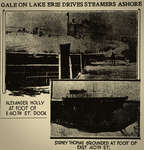Lights Ashore Not Visible to Vessel
- Publication
- Toronto World (Toronto, ON), 22 Nov 1913, p. 1
- Full Text
- Lights Ashore Not Visible to Vessel
_______
Investigation Into Wreck of Turret Chief Shows Boat to Have Been Well Equipped and Seaworthy -- Storm Signals Not Ignored -- Crew's Hardships in Woods.
_______(Special to The Toronto World).
KINGSTON, Nov. 21.--The awful storm on the upper lakes, with its toll of death was recalled here today when the first of a series of investigations was opened by Capt. H. St. G. Lindsay, wreck commissioner, Ottawa, with Capt. W. G. Batten, Kingston, and Capt. Francis Nash, Montreal, sitting as nautical assessors. Capt. Lindsay stated that the decision would be given out at Ottawa in the course of a few days.
The investigation conducted here had to do with the stranding of the steamer Turret Chief, five miles east of Copper Harbor on the morning of Nov. 8.
Francis King, of Kingston, appeared on behalf of the vessel owners, the Canadian Lakes and Ocean Navigation Co., altho the obat is operated by the Merchants' Mutual Line.
Officers who gave evidence besides Capt. Paddington were: Joseph Phillips, first officer; William Bowman, second officer; James Rathbone, chief engineer, and H. Dorey, second engineer.
All the witnesses recalled the suddenness with which the storm came up. Everything was all right up to 9 o'clock on the night of Nov. 7, the wind changing from southwest to north and blowing a regular hurricane with snow and sleet. All declared that no lights were visible at the Soo or Whitefish Point. They had no idea they were drifting so near shore. No soundings had been taken, as it was not thought necessary.
The crew gave a graphic description [ p. 3] of the vessel's going ashore, striking against a ridge of rock. It was a miracle that all were not killed. For two days they lived in the woods in a hut they made out of brushwood. Luckily they had provisions on board the steamer.
Capt. Paddington's opinion was that the steamer could be saved if the weather remained good, but if the boat had to be left all winter it was not likely it could be saved.
The crew, in stating they could see no lights, did not mean that the lights were not lit. They blamed their inability to see to the storm. The captain said if he had seen the storm signals at Whitefish Point he would not likely have gone on, but was not sure what he would have done.
Captain Lindsay pressed him as to the attitude of captains towards storm signals, and the witness said some paid attention to them and some did not.
No evidence was given to show that the company owning the vessel had been negligent in the way of equipment, and no evidence of storm signals being ignored. The vessel was shown to be a seaworthy craft, well equipped.
- Media Type
- Newspaper
- Text
- Item Type
- Clippings
- Date of Publication
- 22 Nov 1913
- Subject(s)
- Personal Name(s)
- King, Francis ; Paddington, Thomas ; Phiillips, Joseph ; Bowman, William ; Rathbone, James ; Dorey, H.
- Corporate Name(s)
- Canadian Lakes and Ocean Navigation Company ; Merchants Mutual Line
- Language of Item
- English
- Geographic Coverage
-
-
Ontario, Canada
Latitude: 43.65011 Longitude: -79.3829
-
- Copyright Statement
- Copyright status unknown. Responsibility for determining the copyright status and any use rests exclusively with the user.
- Contact
- Maritime History of the Great LakesEmail:walter@maritimehistoryofthegreatlakes.ca
Website:


